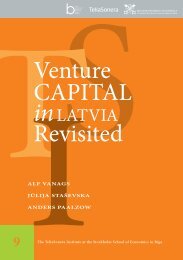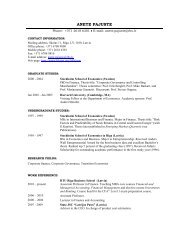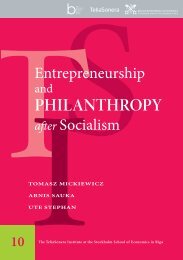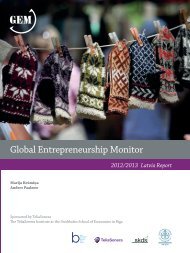A. Vanags, M. Hansen, 2005 - BICEPS
A. Vanags, M. Hansen, 2005 - BICEPS
A. Vanags, M. Hansen, 2005 - BICEPS
Create successful ePaper yourself
Turn your PDF publications into a flip-book with our unique Google optimized e-Paper software.
end we first designed an interview template which contained a mix of qualitative and<br />
quantitative questions. Thus, some of the questions sought direct opinions on issues such<br />
as:<br />
why an institution emerged<br />
whether there were certain gaps to be filled<br />
the future outlook of the sector<br />
the attitude of government to the private sector<br />
the quality of the service offered by the private sector, and so on.<br />
Other questions were more factual ones related to size and quality of faculty,<br />
characteristics of the student body, facilities, and the number of programmes offered.<br />
We also asked institutions to assess on a scale of 1 (low/nothing) to 7 (very high) how<br />
they perceive competition in general in the educational sector, how they perceive<br />
competition with the public sector and with the private sector, respectively, how<br />
important they find the private sector in their country, the degree of collaboration with<br />
institutions in their country and abroad and the size of their fees compared to other<br />
private institutions and to the public sector, respectively.<br />
In each country 5 or 6 institutions were chosen for interviews. Institutions were selected<br />
loosely on the following criteria: Big, in terms of student body and diverse, in terms of<br />
programmes, ie not just a selection of various business schools. For Lithuania,<br />
institutions from the three major cities, Vilnius, Kaunas and Klaipeda were chosen since<br />
this country, in contrast to Estonia and Latvia, does not exhibit a massive concentration in<br />
the capital (Vilnius). For Belarus, the capital, Minsk, is home to by far most of the<br />
institutions but to choose eg one institution from another city was simply impractical. The<br />
interviews were conducted in the autumn of 2004 and the spring of <strong>2005</strong>, typically with<br />
the rector or vice-rector of the institution and often in the presence of more staff.<br />
Interviews typically lasted 1 – 1½ hours.<br />
5






